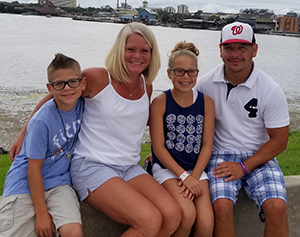
A life-saving liver transplant
At 4 feet 5 inches, weighing in at 72 pounds, she may look tiny, but Mya Santini is a giant when it comes to courage and heart. At only four years of age, she underwent a seven-hour surgical procedure to transplant her new liver. But Mya wasn’t alone in her journey. Her mother, Bridget, donated a portion of her own liver to save her daughter’s life.

The first hint that something was wrong started in October 2009. “Mya just wasn’t feeling well,” recalls Bridget. A quick trip to the pediatrician showed that Mya was anemic and her liver enzymes were a little elevated. But within a matter of weeks, the little girl seemed just fine.
“But in May 2010, Mya started throwing up randomly,” says Bridget, “and we noticed she was putting on weight.” The culminating event occurred on June 1, when the daycare center called and reported that Mya was lethargic—she couldn’t stay awake for more than five minutes. More alarming still, her heart was racing. Bridget rushed Mya to the emergency department at a community hospital, and while they were waiting, the little girl looked up at her mother. Bridget was stunned to see that the whites of Mya’s eyes were yellow.
After running tests for 36 hours, the doctors realized that Mya would need a more advanced level of care, and they arranged to have her transferred to CHoR. “When we arrived in the pediatric intensive care unit, an entire team was waiting for us,” says Bridget. “And they went into immediate action. We knew that Mya’s liver was failing, but the question was ‘Why?'” After additional evaluation, the Santini family had the answer: Mya was suffering from autoimmune hepatitis type 2.
The doctors explained that 60 percent of Mya’s liver was destroyed and would not regenerate. There was no time to lose. Mya had to have a live transplant. Fortunately, CHoR families have access to the only pediatric transplant surgeon in the region, through VCU Health Hume-Lee Transplant Center.
 The next few hours were a whirlwind. Mya’s father, Roger Santini, was ruled out as a liver donor due to his diabetes, so Bridget was whisked to various departments for blood typing, an MRI, EKG and blood to determine if she was a match. At 5 p.m. that afternoon, the family learned that Bridget could donate a portion of her liver to Mya.
The next few hours were a whirlwind. Mya’s father, Roger Santini, was ruled out as a liver donor due to his diabetes, so Bridget was whisked to various departments for blood typing, an MRI, EKG and blood to determine if she was a match. At 5 p.m. that afternoon, the family learned that Bridget could donate a portion of her liver to Mya.
Whether to donate wasn’t even a question in Bridget’s mind. She would do whatever it took to give her daughter a second chance. But there were arrangements that had to be made. Bridget’s parents stepped forward to care for Mason, Mya’s two-year-old brother. Bridget’s employer made it clear that taking care of Mya was paramount—Bridget’s position as IT manager would be waiting when she recovered from surgery.
On June 14, the day after Bridget’s 35th birthday, mother and daughter underwent major surgery. Bridget was in the operating room for more than eight hours and Mya for more than seven. According to the surgeon, both came through the operations with “flying colors.” Just three days later, Bridget and Mya were walking down the halls of the PICU, well on their way to recovery and a new healthy life—thanks to a shared organ. Each year, the Santinis celebrate both mom’s birthday and Happy Transplant Day.
 Today, Mya is a 12-year-old dynamo. She plays softball, soccer and is a competitive gymnast. But it hasn’t been an easy road, says Bridget. “The first two years after the transplant, Mya was hospitalized 10 times.” The anti-rejection drugs that Mya will have to take for the rest of her life suppress her immune system, leaving her vulnerable to illness and infection. “Initially, Mya had to take 13 medications a day. Now, we’re down to only two, and her immune system seems to be getting stronger. We haven’t had a hospital stay since 2013,” adds Bridget, as she discretely knocks on wood.
Today, Mya is a 12-year-old dynamo. She plays softball, soccer and is a competitive gymnast. But it hasn’t been an easy road, says Bridget. “The first two years after the transplant, Mya was hospitalized 10 times.” The anti-rejection drugs that Mya will have to take for the rest of her life suppress her immune system, leaving her vulnerable to illness and infection. “Initially, Mya had to take 13 medications a day. Now, we’re down to only two, and her immune system seems to be getting stronger. We haven’t had a hospital stay since 2013,” adds Bridget, as she discretely knocks on wood.
In addition to the drug regime and medical visits, the Santini family’s lives have changed in other ways since the transplant—many of them positive.
“When we learned that Mya needed a liver transplant in order to survive my, husband and I were not the only ones to offer an organ. Our family, friends and coworkers lined up, willing to make this incredible sacrifice for our child,” says Bridget.
The community also recognized the financial strain that Mya’s medical condition put on the family. As a way to help, friends organized a golf tournament called the No Shots/No Nibbles Charity Golf Tournament. “Mya called the little finger pricks to draw blood ‘nibbles,'” says Bridget. “Whenever we went to the doctor, she would beg ‘No shots or nibbles, Mommy.'” The funds raised through this annual event are placed in a special account to help defray Mya’s extraordinary medical expenses now and in the future.
The relationships that the Santini family established with the doctors, nurses and other health care professionals at CHoR are deep and sustaining. “If there were a word greater than ‘outstanding,’ I would use it,” says Bridget. “The doctors listen to us as parents. They always make us feel like we are part of Mya’s care team. Every one of them is special to us. How can we ever thank them enough?”
“Mya’s surgery truly did transform our lives,” reflects Bridget. “Mya had to grow up more quickly than other children. She is an old soul. Just imagine a little girl assuming responsibility for taking medications needed to save her life. Mason has been affected, too. He has always been very loving and kind to his big sister, even though he has had to make many sacrifices due to Mya’s medical condition.” As for Bridget, being Mya’s organ donor was a profound experience. “This has been the most rewarding thing I’ve ever done. It is incredibly gratifying to look at my child and know I gave her life not once, but twice.”
About living organ donations. More than 15,000 adults and children in the U.S. are waiting for a liver transplant, but there are only 6,000 livers from deceased donors available for transplant each year. Living donation takes place when a healthy person donates part of their liver to someone in need of a transplant. There are many benefits to living organ donations:
- Individuals in need of an organ can have a transplant sooner — without the anxiety of being on a national waiting list for months or even years
- The organ recipient can receive a transplant earlier in the disease process, while they are in better physical condition and more likely to make a good recovery following surgery
- Organs of living donors are healthier and have longer viability after transplant
- The organ donor has the opportunity to do something truly amazing — save the life of a family member, friend or even a total stranger. (Yes, there really are “Good Samaritan” donors who make the decision to offer an organ to another human being in need.)
If you would like to learn more about being an organ donor, please call the VCU Health Hume-Lee Transplant Center at (804) 628-0711 and speak with one of our living donor coordinators.
